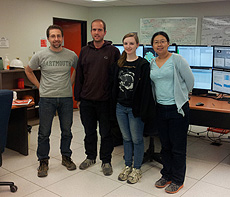Lucky stars, clear night for DES surveyors
 |
| These scientists, part of the DES survey team, were on shift during a night of firsts for the team. From left: Chris D'Andrea (University of Portsmouth, UK); Dominik Gangkofner (LMU, Germany); Christina Krawiec (University of Pennsylvania); Ting Li (Texas A&M). Photo courtesy of Chris D'Andrea, University of Portsmouth |
Once in a while the stars align in your favor. They certainly did for a group of Dark Energy Survey observers using the Dark Energy Camera on a cloudless Chilean evening, clearing the way for an observational night of firsts.
On the night of Nov. 11, the group for the first time captured in one shift images of all 10 of the DES supernova target fields. The fraction of time the camera's shutter was open was the highest it had ever been. And the data taken was so superior, the group had to come up with a new way to handle it.
Although the team had observed all 10 fields before and in good conditions, they'd never observed them all in a single night.
Within the Dark Energy Survey, the Dark Energy Camera is shared between supernova survey and a wide-area survey. Weather is a factor not only in how good the data will be, but also in which fields get shift time.
In November, the camera was taking turns between the wide-area survey and the supernova survey. The wide survey gets dibs when the weather is propitious, but after it claims a certain number of nights on the camera, it has to relinquish a shift to the supernova survey regardless of weather. Otherwise, the supernova survey dates would be spaced too far apart to easily connect the time-separated data.
Luckily, it was the supernova survey's turn that outstanding night, which was long enough to allow seven hours of picture taking — enough time to photograph 10 supernova fields.
While capturing all 10 doesn't materially change the science the group does with the data, the images' unprecedentedly high quality did change how the team had to process the pictures.
Typically, supernova surveyors subtract from their newest image a combination of top-notch older images, called a template, of the same piece of sky. The starlight that remains after subtraction is a candidate for a new supernova event. Light is unavoidably "smeared" by the atmosphere by the time it reaches the camera. Scientists smear the points of light in the template to match the amount of smearing in the new image to aid image subtraction.
But this time, the group couldn't follow their protocol: Unusually, the smearing in the new image was less present than that in the template. The new images were too crisp.
The algorithm was not set to think that the new data could be better than the old data. So the team smeared the new data to match the old.
Ting Li of Texas A&M University, run manager and Fermilab liaison during those shifts, said the team knew even before they inspected their data that it would be exceptional.
"Even as we were observing, we could tell the data was so good," she said.
The happy conditions were repeated a week later, on Nov. 18, allowing the team to once again take high-quality images of all 10 target fields.
—Leah Hesla
|